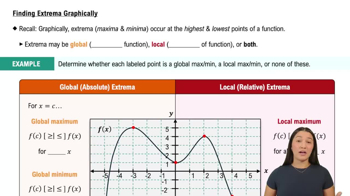Table of contents
- 0. Functions7h 52m
- Introduction to Functions16m
- Piecewise Functions10m
- Properties of Functions9m
- Common Functions1h 8m
- Transformations5m
- Combining Functions27m
- Exponent rules32m
- Exponential Functions28m
- Logarithmic Functions24m
- Properties of Logarithms34m
- Exponential & Logarithmic Equations35m
- Introduction to Trigonometric Functions38m
- Graphs of Trigonometric Functions44m
- Trigonometric Identities47m
- Inverse Trigonometric Functions48m
- 1. Limits and Continuity2h 2m
- 2. Intro to Derivatives1h 33m
- 3. Techniques of Differentiation3h 18m
- 4. Applications of Derivatives2h 38m
- 5. Graphical Applications of Derivatives6h 2m
- 6. Derivatives of Inverse, Exponential, & Logarithmic Functions2h 37m
- 7. Antiderivatives & Indefinite Integrals1h 26m
- 8. Definite Integrals3h 25m
5. Graphical Applications of Derivatives
Intro to Extrema
Problem 4.1.16
Textbook Question
Use the following graphs to identify the points on the interval [a, b] at which local and absolute extreme values occur. <IMAGE>
 Verified step by step guidance
Verified step by step guidance1
Examine the given graphs to identify the interval [a, b] and note the endpoints of this interval, as extreme values can occur at these points.
Look for critical points within the interval where the derivative of the function is zero or undefined, as these points are potential candidates for local extrema.
Evaluate the function values at the critical points identified in the previous step, as well as at the endpoints of the interval [a, b].
Compare the function values obtained from the critical points and the endpoints to determine which are the highest and lowest values, indicating local and absolute extrema.
Conclude by summarizing the points where local and absolute extreme values occur based on your evaluations.
Was this helpful?

 5:58m
5:58mWatch next
Master Finding Extrema Graphically with a bite sized video explanation from Callie
Start learning





